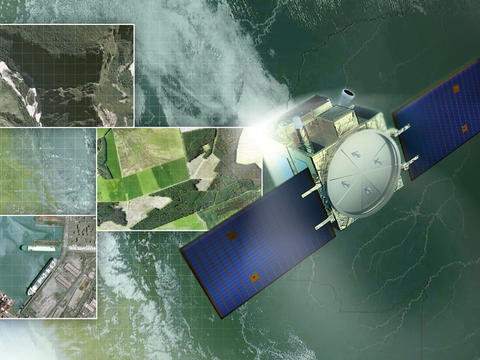CO3D constellation
The four CO3D satellites are the latest generation of compact satellites that will map the globe in 3D from low Earth orbit from 2025. They will meet the needs of both the public and private sectors. Weighing around 300kg, the CO3D satellites will join Airbus’ fleet of optical and radar satellites, strengthening the company’s ability to meet the growing needs of very demanding applications. Inaugurating a generation of highly innovative and all electric platforms, these extremely agile satellites will instigate the way images are acquired, processed and transferred to the ground.
Together with the four Pléiades Neo satellites, the CO3D constellation will offer unrivalled refresh rates for very high-resolution imagery.
CNES and Airbus have established a virtuous partnership for this project. An integrated and agile governance between both partners will enable the mission to be optimised to cover both private and public needs. The data collected by the CO3D constellation will be available for the scientific and defence institutional partners of the programme.

CO3D key features and performances
4 satellites
100% electrical propulsion system
50 cm resolution
300 kg mass
<3 years worldwide digital surface model coverage
The project in brief
Each CO3D satellite will be equipped with a unique optical instrument, with a spatial resolution of 50 cm in the visible red, green, blue and near infrared bands. After specific ground processing of the results, they will provide 3D maps of all the land areas of the globe, called digital surface models (DSMs) with an altimetric resolution of around one metre.
The DSM produced will represent approximately 25 million km² per year, a rate of accuracy that is unique in the world. They will be used by defence and civil society but should also open up new perspectives for start-ups or established companies that use them for commercial purposes. The entire globe should be covered within 5 years, and depending on the needs of certain specific users (glaciologists, snow scientists, geologists, etc.) certain areas will be remodeled every few months.
The latest earth observation news
in the spotlight
-

Stories Innovation
Improving the world we live in with AI-powered products
Some Airbus space products help address land use issues by using artificial intelligence to improve satellite imagery analysis. -

Press releases Space
Ariane-6 launches CSO-3: double success for France and Europe
-

Press releases Space
Airbus-built Biomass forest measuring satellite shipped to Kourou
-

Stories Space
Inside Atlid, mastering atmospheric LiDAR technology for space
-

Stories Space
Preserving Madagascar’s biodiversity using satellite imagery



